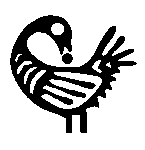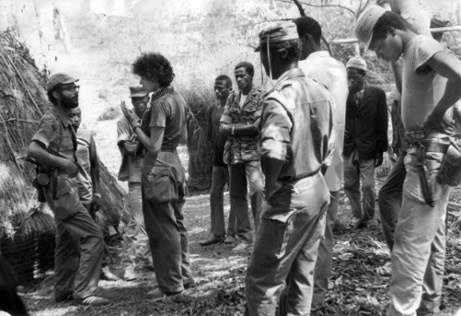
No Easy Victories: African Liberation and American Activists over a Half Century, 1950-2000
Gail Hovey, and Charles Cobb Jr.
Published by Africa World Press.
home
|
No Easy Victories: African Liberation and American Activists over a Half Century, 1950-2000 |
Edited by William Minter, Gail Hovey, and Charles Cobb Jr. Published by Africa World Press. |
|
An Unfinished Journey by William Minter The 1950s: Africa Solidarity Rising by Lisa Brock The 1960s: Making Connections by Mimi Edmunds
The 1970s: Expanding Networks by Joseph F. Jordan
The 1980s: The Anti-Apartheid Convergence by David Goodman
|
Featured TextThe following text is excerpted from No Easy Victories for web presentation on allAfrica.com and noeasyvictories.org. This text may be freely reproduced if credit is given to No Easy Victories. Please mention that the book is available from http://noeasyvictories.org and http://africaworldpressbooks.com. Media for the Movement: Southern Africa MagazineGail Hovey 
Stephanie Urdang of the Southern Africa Committee was invited to travel to liberated areas of Guinea-Bissau with PAIGC in 1974. Here she speaks with her translator, Mario Ribeira. Photo courtesy of Stephanie Urdang. Gail Hovey, one of the editors of this book, was a founder of Southern Africa magazine and an original member of the Southern Africa Committee. She remained involved with the magazine from 1964 to 1975. During the two years she spent in Africa, living in the Northern Transvaal from 1966 to 1967, she regularly sent information to the magazine in New York without the knowledge of the South African authorities.
If you care about civil rights in the United States, you need to care about the freedom struggles in Southern Africa. —Hank Crane, Africa Secretary, World Student Christian Federation When the National Student Christian Federation, the student movement of the mainline Protestant churches, met for its annual summer meeting in Chicago in 1964, the students in attendance were well aware that this was Freedom Summer. Many of us had already been involved in one aspect or another of the civil rights movement. At that meeting we heard a new challenge from Hank Crane, who had grown up in Congo, the son of Presbyterian missionaries who had arrived there in 1912. Crane’s father-in-law and mother-inlaw, Roy and LeNoir Cleveland, were also missionaries; although they were white Southerners, they had been recruited to go to the Congo by African American missionary William Sheppard. Sheppard and others in the Presbyterian mission in Congo’s Kasai area had been active in exposing the grisly horrors of King Leopold’s rubber trade in the Congo at the beginning of the twentieth century (Hochschild 1998, 164–65; Kennedy 2002; Phipps 2002). Before Crane spoke to us in 1964, he had spent several years traveling around Africa for the World Student Christian Federation, based in Northern Rhodesia, which would become independent Zambia that October. Crane found a receptive audience in the students that day. In the fall we took up his challenge to focus on liberation in Southern Africa. David Wiley, then a graduate student at Princeton University and Seminary, who had worked with the Student Christian Movement in white-ruled Southern Rhodesia in the early 1960s, and Ken Carstens, a white South African Methodist minister in exile since 1961, began the process of educating us, explaining the workings of the apartheid state and setting the larger Southern African context. We continued to meet on a weekly basis, first to educate ourselves and then to determine what action to take. Although this new Southern Africa Committee (SAC) was initially intended to be national, limitations of time and money quickly narrowed our membership to students at East Coast schools, especially Union Theological Seminary and Columbia University in New York City. When Students for a Democratic Society called for a demonstration at Chase Manhattan Bank in the spring of 1965 to protest Chase loans to South Africa, we were ready to participate, as were SNCC and CORE. Chase was chosen as a target not only because it was a leading member of a consortium of banks that provided a revolving loan fund to the South African government, but because it had been instrumental in resolving the crisis in the South African economy after the Sharpeville killings in 1960. Revealing our preference for reconciliation, and also our naiveté, Southern Africa Committee members insisted that an effort be made to negotiate with the bank before taking action against it. At a lunch appointment in Chase’s swanky dining room, we were hosted by a vice president for public relations. I was amazed to discover that we knew more about Chase’s involvement in South Africa than he did. Instead of addressing the support provided by the bank to the apartheid regime, he wanted to talk about the possibility of scholarships for South African students. For some of us it was a revelatory moment, the beginning of an education in the nature and power of international capital. Our argument that supporting a more just society in South Africa would be in Chase’s longterm interest cut no ice. What mattered was profit in the short term and co-opting Africans through scholarships and capitalist economic development. SAC joined the demonstration in front of the bank and some of our members were among the 49 arrested. Our next target was First National City Bank, now Citibank, which was a part of the same revolving loan fund. SAC members talked with bank officials, seminary and university administrators, faculty, and students. We asked people to withdraw their accounts if the bank had not met our demands by a specified date. We also approached the denominations and church agencies that had their offices at the Interchurch Center in New York, asking them to withdraw accounts. This campaign continued in collaboration with the American Committee on Africa, the initial public withdrawal involving some 70 accounts by individuals and a $20,000 withdrawal of Barnard College’s student council fund. We saw this strategy as an effective way to confront the public with the issue of American involvement with apartheid. We gave up our illusions about convincing the banks to change their ways of doing business. It would take more years and radically increased pressure that ultimately affected their bottom line before the banks would finally end their loans to South Africa. In 1965, most Americans knew very little about apartheid or about the countries of Southern Africa. As a new convert to concern about the region, I found it instructive that the November 11, 1965 Unilateral Declaration of Independence in Rhodesia received such minimal coverage in the U.S. press. SAC understood that the declaration was a daring and desperate effort on the part of whites, under the leadership of Ian Smith, to perpetuate minority rule in the British colony. Convinced of the seriousness of the crisis in Rhodesia and of the need for information, we started what quickly became a biweekly news summary on Southern Africa. At first our sources were mostly British. Before long we established contact with the Zimbabwean nationalist movements and in time subscribed to publications printed in Southern Africa by the liberation movements and by the regular press. What began as the “Rhodesian News Summary” evolved over the next three years into Southern Africa magazine. When the NSCF became the University Christian Movement and then went out of existence as a national movement in 1969, SAC became independent and continued as a cooperative. The quality of Southern Africa magazine improved significantly over time with the involvement of ACOA staff member Janet Hooper and graduate student Susan Geiger, both of whom had spent time in Africa, and South Africans Stephanie Urdang and Jennifer Davis, among others. The committee operated on a shoestring and was subject to FBI infiltration and IRS investigation, and it finally ceased publication in 1983. But for 15 years the magazine provided its readership, some 4,000 subscribers, with information on the progress of the liberation struggles and analysis of U.S. governmental and economic involvement with the region. Unlike Africa News, which emerged from a North Carolina branch of the Southern Africa Committee, Southern Africa magazine was primarily a vehicle for communication within the movement rather than something intended for a broad public audience. In the period before Africa rated even minimal media attention, it was a vital resource, joining Liberation News Service and the Guardian, both also based in New York, in keeping African freedom on the movement agenda. The women in the Southern Africa magazine collective were also involved in the emerging women’s movement in New York and made connections between that movement and the anticolonial and anti-apartheid movements in Africa. We learned from and reported on the roles African women were playing in national liberation struggles. The connections we established resulted in, among other things, Stephanie Urdang’s Fighting Two Colonialisms: Women in Guinea-Bissau (1979) and her later book on women in Mozambique, And Still They Dance (1989). Another committee member, Susan Geiger, went on to teach women’s studies at the University of Minnesota and wrote TANU Women: Gender and Culture in the Making of Tanganyikan Nationalism, 1955–1965 (1997). These books, among others, preserved and made available to future generations the essential contribution of women in the history of African resistance, knowledge of which was in danger of being lost. |
This page is part of the No Easy Victories website.